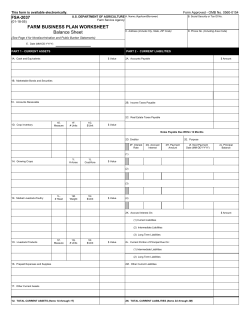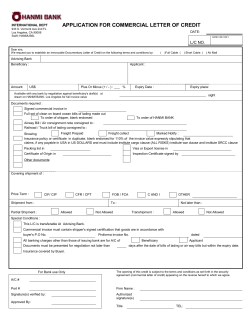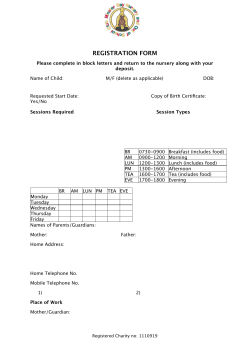
L How to Quantify and Manage Liability Stickiness By Leonard Matz
Risk Measurement How to Quantify and Manage Liability Stickiness By Leonard Matz A practical guide for evaluating deposits and nondeposit liabilities. L iquidity risk management is not just about liquid asset reserves. It isn’t even mainly about liquid asset reserves. Face it: Most banks hold relatively small amounts of unencumbered, marketable assets compared to potential liquidity needs under stress conditions. It is not unusual to see banks with “marketable securities” equivalent to less than 20 percent of total assets—with half of that only marketable in normal capital market conditions—and half of that 10 percent already encumbered for one purpose or another. Unencumbered, securities equivalent to just five red,, marketable ma arke percent peercen nt off total totaal assets isn’t a whole lot of protection p in a stressed stresssed funding ffun g environment. environment. Did someone Okay, what is D som meon ne ssay “core co deposit”? os kay, but w a ccore dep deposit? A deposit obtained through a branch posit?? osit obtained th ough b offi insured deposit obtaine obtained from ffi fice?? An insu fice? u ed d deposit? osit? A deposi a consumer or small business? Notice that all of these questions attempt to defi ne a stable fine stable deposit depos d t by y virtue of a single characteristicc of stability. ability The problem for liquidity risk managers is actually bigger than how or how accurately we define core deposits. The truth is that some nondeposit liabilities are more stable than some deposits. The question is not: Which deposits are least likely to be withdrawn during a liquidity event? The question is: Which liabilities are least likely to be withdrawn during a liquidity event? What Is Stickiness? Liquidity risk managers need to forecast future cash flows. Part of that exercise requires forecasting potential liability losses in different scenarios and at different stress levels. We need a method to estimate liability stability—what we now call “stickiness.”1 FEBRUARY–MARCH 2009 For the most part, stickiness is the result of the funds providers’ confidence in the bank. The Bank for International Settlements (BIS) defines stickiness as the tendency of funding not to run off quickly under stress.2 Let’s first identify eight characteristics that individually—but especially in combination— determine stickiness. 1. Is the liability an insured deposit? Once upon a time, all government-insured deposits were confidently assumed to be sticky. Despite the occasional panic, government insurance is undoubtedly a major factor that increases stickiness. But, as the following anecdote makes clear, government insurance is no longer sacrosanct. The rush to withdraw money ... came a day after fears arose that Countrywide Financial [the biggest home-loan company thee Uni United States] e th om me loan co pany in th ed Sta tes could file for bankruptcy protection because of cou uld ile for ban uptcy protect on beca ause o a worsening credit crunch stemming from the sub-prime mortgage meltdown. The parent firm borrowed $11.5 billion Thursday by using up an existing line of credit from 40 banks, saying the money would help the lender meet its funding needs and continue to grow. “It’s because of the fear of the bankruptcy,” said [Bill] Ashmore, President of Irvine’s Impac Mortgage Holdings … . “It’s got my wife totally freaked out,” he said. “I just don’t want to deal with it. I Leonard Matz is Director, Liquidity and Interest-Rate Risk Consulting, at SunGard–BancWare, Boston, Massachusetts. Contact him at lmm50@comcast.net. BANK ACCOUNTING & FINANCE 39 Risk Measurement don’t care about losing 90 days’ interest, I don’t care if it’s FDIC-insured—I just want it out.”3 2. Is the liability secured? Whether it is a deposit or a capital markets borrowing such as a repo, backing by quality collateral is another strong contributor to stickiness. 3. Are the funds controlled by the owner? When the funds placed in your bank are controlled by an agent or manager of the money, that agent may have a legal or quasi-legal responsibility to preserve the principal. For example, pension fund managers. On the other hand, if the controller of the money is the consumer or small business that owns the funds, the bank is less likely to lose this money at the first sign of trouble. 4. Does the depositor or liability counterparty have other relationships with the bank, such as loans? A funds provider that has a relationship with the bank may be reluctant to incur the costs, time and effort needed to transfer all of his or her accounts. More typically, the stickiness of the funds from counterparties who have relationships with the bank stems simply from familiarity. 5. Is the dep depositor or liability counterparty a net borrower? providers who owe the bank b bo orrow wer?? Funds F sums amount funds that sum ms large llarger er than the am ount of the fund they provide the ey y provi p ide may y simply y take comfort omfort iin their right of off offset. rig ght o fse 6. Do Does Internet access to oes the t fu ffunds nds d provider ovider lack ack In ernet ac the h ffunds? Typically, few, if any, administrative hurdles restrain transfers fer from om e-banking e-baank ng accounts. accounts. Customers with only an online relationship, who y nline relationsh p, w wh o can more easily move funds electronically, may be significantly more prone to changing firms to obtain better rates or to react to negative news about their current firm.4 For purposes of liquidity stress testing, ATM withdrawals can be considered separately from evaluations of deposit stickiness. 7. Is the depositor or liability counterparty financially unsophisticated? For example, not likely to follow financial news closely. “Even outside of the e-banking sphere, well-informed consumers may prefer not to deal with a bank whose reputation is questioned, simply to avoid the frictions of recovering funds if a failure occurs, even if their funds are fully covered by deposit insurance.”5 8. Did the bank obtain the deposits directly rather than through a third-party deposit broker? 40 BANK ACCOUNTING & FINANCE Two related concerns apply to brokered deposits. First, it is plausible to assume that access to funds from this source will be constrained—if not cut off—in bank-specific stress scenarios likely to involve a loss of confidence in the bank. Second, severe stress scenario forecasts must reflect that fact that deposits obtained by U.S. banks from brokers are legally restricted to “well-capitalized” banks. (Exceptions can be made.) Accordingly, forecasts for bank-specific scenarios that might lead to a reduction in the bank’s capital should treat all deposits obtained from brokers as volatile—not sticky. Putting It All Together Step 1 Using the eight characteristics defined above, we can begin to identify the sticky and volatile liabilities. The obvious problem is that the information we need comes from different sources in the bank’s records. For example, two types of liabilities, Internet deposits and brokered deposits, are identified by the marketing channel. Exhibit 1 shows a work sheet that can be used to identify the sources for the information we need. Step 2 We w will il always alw ways lack lack a clear, cle , bright bright line ine separating se separa ting g sticky st cky from volatile liabilities. Instead, we must recognize rom volat le liab bilit e nstead, w must recognize a continuum. Once we know the information sources we need to quantify sticky and volatile liabilities, with as much granularity as possible, we can combine all of our information and create such a continuum. We can use the work sheet in Exhibit 2 to reflect a stickiness continuum.6 (Replace the list of counterparty and product types shown in the exhibit with your own categories.) Step 3 Stickiness is scenario dependent. Most of the eight characteristics discussed above are descriptors for counterparty confidence. This is vital information for bank-specific scenarios involving a loss of confidence in the bank—especially moderate and high-level FEBRUARY–MARCH 2009 Risk Measurement Exhibit 1. Stickiness Worksheet Identification Sources* Deposit size. Liability type (for example, repo) or counterparty type (for example, municipal). Customer information records. Stickiness Characteristic Are the funds insured? Are the funds secured? Funds controlled by the owner rather than a manager, agent or fiduciary? Does the funds provider have other relationships with Customer information records. the bank? Is the funds provider a net borrower? Customer information records. Does the funds provider lack Internet access to the funds? Channel. All deposits not obtained through the Internet. Is the depositor or liability counterparty likely to be relatively insensitive to financial information? Did the bank obtain the deposits directly rather than through a third-party deposit broker? Combination of account size and customer demographics (for example, age, income). Channel. * Avoid double-counting. For example, many customers with small accounts are also relatively insensitive to financial information. * The more granularity the better. For example, for secured counterparties, list repo borrowings and municipal deposits separately. For funds providers who are managers, agents or fiduciaries, list pension funds, mutual funds and other counterparty types separately. Exhibit 2. A Stickiness Continuum Tolerance for credit quality or liquidity concerns Entity Amount Percent Money market mutual funds Very ery y sensi ssensitive itive to perceived deterioration de eteri t iorati tiion i iin credit quality safety orr safe ety y Rating sensitive providers Pension funds Insurance rance co companies Other er funds providers with fiduciary responsibility Broker/dealers Reg giona and m oneey ccenter ter banks in your countr Regional money country Foreign F i b banks k Large corporations Community banks in your market area Local, uninsured, unsecured depositors Only sensitive to credit quality and liquidity when problems are very bad and highly publicized Customers who are net borrowers (their loan balances exceed their deposit balances) Local, secured funds providers Insured depositors stress tests under those scenarios. For most systemic scenarios, on the other hand, the information developed in steps 1 and 2 is barely relevant. FEBRUARY–MARCH 2009 Stress tests involving systemic scenarios should consider quite different influences on liability stickiness. Examples include the following: BANK ACCOUNTING & FINANCE 41 Risk Measurement Loss of rate-sensitive deposits in scenarios in which market rates are likely to be high Early withdrawal of retail time deposits in scenarios where market rates are likely to be high Loss of funds from capital markets counterparties during capital markets flights to quality Reduced availability of funds from all sources during so-called credit crunches Maturity of Time or Term Liabilities Up to this point, we have not considered remaining life as a characteristic of stickiness. This is not because the remaining life of time or term liabilities is less important or less influential than any of the eight stickiness characteristics previously defined. Quite the contrary, remaining life is, in some scenarios, the single most important determinant of stickiness. In any bank-specific scenario, the remaining life for liabilities that cannot be redeemed prior to maturity is arguably more important than any of the eight characteristics defined here. The same is truee for systemic scenarios that do not involve a sys signifi in market rates. sig gnifi ficantt increase ficant inccre Remaining R mainiing life Rem l is addressed ddress d separately sepa ately from fro the other for two reasons reasons: oth her eight e ght stickiness eigh stiick s ffactors fo Remaining life is concept conceptually different from the Reemain ning g li ually di ferent fro other Remaining life is not id identifioth her eight e t factors. act c Rema ing lif able by product type, counterparty type, marketing bll b channel or depositor dem demographics. Instead, graphics. In s ead, it aarisris es from the defining ele element of term liabilities. nt term liabilities. For liquidity risk–management purposes, best-practice diversification treats maturity diversification (also known as rollover risk) separately from diversification by type or product. the approaches outlined in this article. While the remaining life of term liabilities can be clearly and accurately established, for the most part, stickiness is a messy concept. It is hard to identify, hard to quantify and varies based upon scenario and degree of stress. Nevertheless, even subjective quantifi cations of stickiness can be a huge help to liquidity risk forecasts and stress tests. All forecasts are by definition subjective because they require estimation of future conditions or changes that cannot be known in advance with total certainty. And, since useful liquidity stress tests must address very low probability events, little historical data is available for reference. The goal is not an unachievable level of perfection. Instead, our goal is to use stickiness concepts to disaggregate liabilities into a stickiness continuum and, in combination with remaining life, use that information to make the most accurate assumptions we can make. Careful application of the concepts and practical procedures outlined here should substantially improve all liquidity forecasts based on broad assumptions. Endnotes 1 2 3 4 Stickiness: A Messy Concept Readers looking for a simple formula or packaged solution are undoubtedly dissatisfied with 5 6 Describing liability stability as stickiness is a coinage from the mid-1980s, probably attributable to Brian Ranson, then at the Bank of Montreal. Basel Bas el C Committee mm tt e on Ban Banking ng S Supervision, upervisi n BIS BIS, Prin Principles cip es oof Sou nd Liqu dity R isk Ma M men and Sup ervision, Pa ragraph Sound Liquidity Risk Management Supervision, Paragraph 30 (Sept. 2008). E. Scott Reckard and Annette Haddad, A Rush to Pull Out Cash, L.A. TIMES, Aug. 17, 2007, www.latimes.com/business/lafi-countrywide17aug17,0,1835165.story?coll=la-home-center. International Institute of Finance, Principles of Liquidity Risk Management (Mar. 2007), at 17. Id. Adapted from a chart developed by the Office of the Comptroller of the Currency. This article is reprinted with the publisher’s permission from Bank Accounting & Finance, a bimonthly journal published by CCH, a Wolters Kluwer business. Copying or distribution without the publisher’s permission is prohibited. To subscribe to Bank Accounting & Finance or other CCH Journals please call 800-449-8114 or visit www.CCHGroup.com. All views expressed in the articles and columns are those of the author and not necessarily those of CCH or any other person. 42 BANK ACCOUNTING & FINANCE FEBRUARY–MARCH 2009
© Copyright 2025













